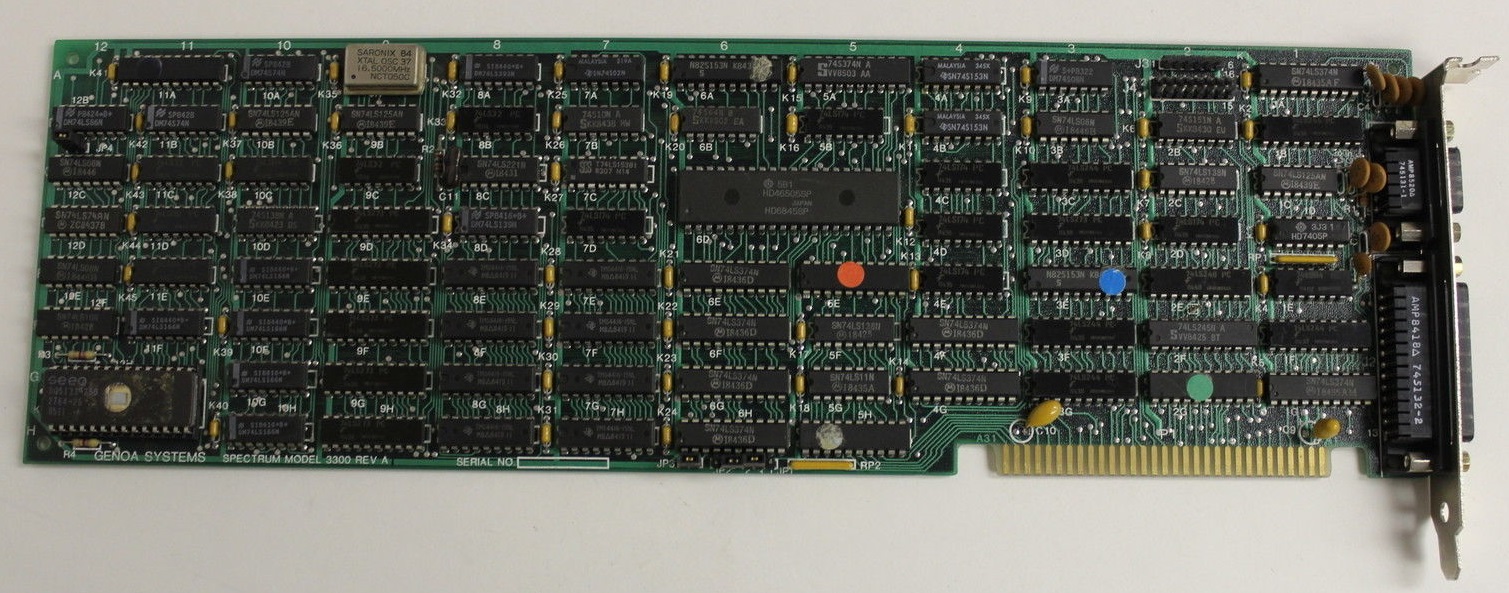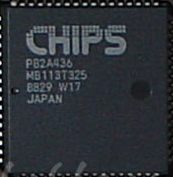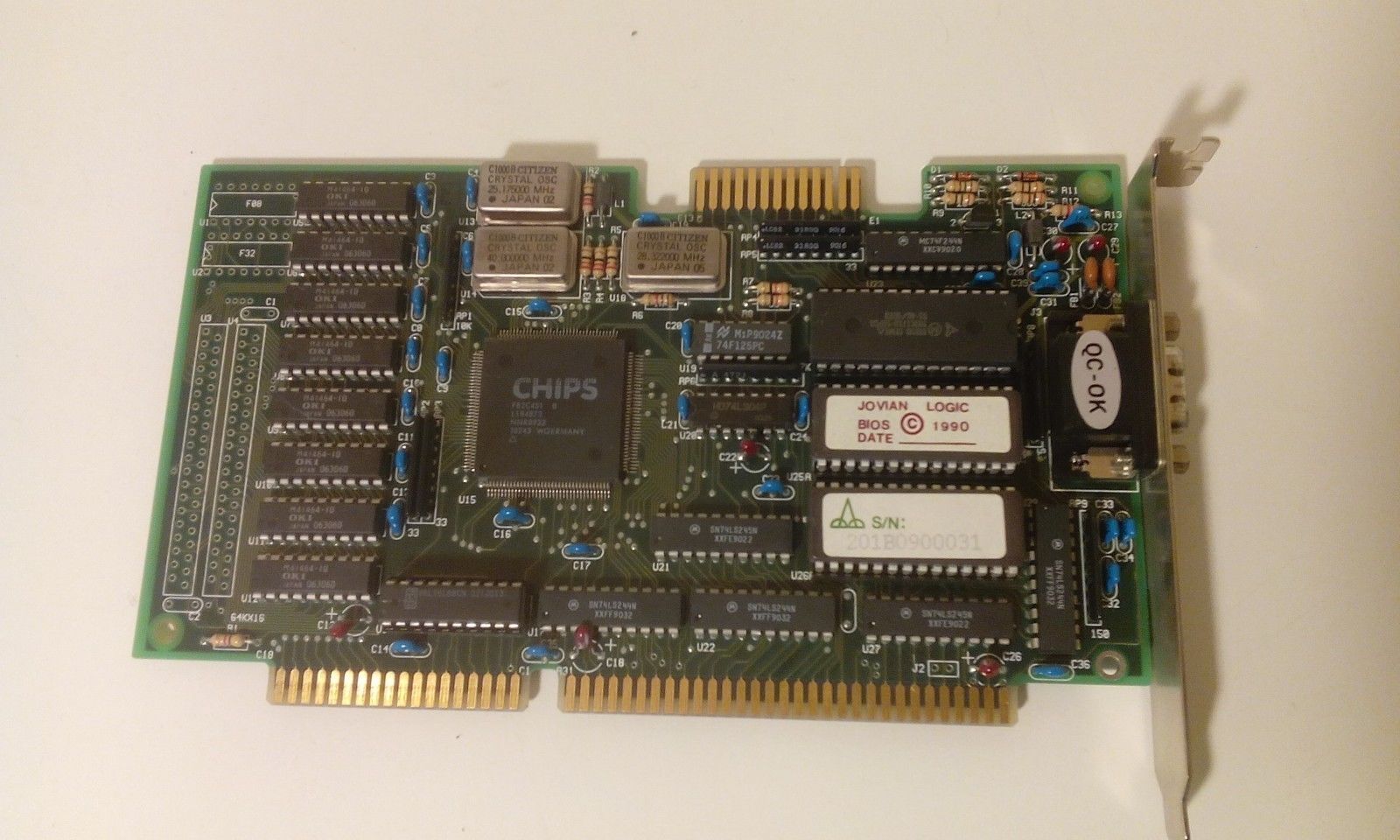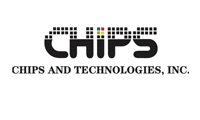C&T were an California-based chipset manufacturer for PC compatible motherboards, graphics cards, and peripherals such as hard disk controllers.
The were notable in 1986 as being the first company to reverse-engineer IBM's EGA to produce their own EGA chipset, which they then sold to numerous graphics card manufacturers.
They were more prominent in the late 1980s, up to 80386DX era. During the laptop boom of the early 90s, their embedded graphics chipsets were hugely popular, being used heavily by OEMs including Dell, Compaq, HP, Acer, and NEC. They were later acquired by Intel in 1997, primarily for their graphics chip business - around this time, laptops and notebooks were shifting to use graphics chipsets from NeoMagic like the NMG4 and MagicGraph 128XD.
 P82C100 / P82C101 XT Chip P82C100 / P82C101 XT Chip
Launched: October 1987
Bus: 8-bit ISA
"Chips and Technologies Inc. announced last week a microprocessor system logic chip that the company said is likely to accelerate the cloning of IBM's PS/2 computer line.
The 82C100 chip, scheduled for volume shipment by October, will offer a 25 percent speed improvement over the IBM PS/2 Model 30, according to Chips and Technologies. The chip supports the Intel 8088 and 8086 CPUs as well as the NEC V20 and V30 microprocessors, which emulate the Intel chips.
Including support chips for the 82C100, a Model 30 compatible can be assembled using fewer than 25 components, not including memory chips, compared to more than 63 components for IBM's Model 30, the company said.
Costing $51.30 in quantity, the 82C100 chip could be used to produce a Model 30 clone to sell for under $1,000, said company spokesman Sikander Naqvi. The company will also offer a set of support chips to make up a Model 30-compatible motherboard, he said.
Although the Model 30 has few features that distinguish it from its IBM XT predecessor, there is a strong demand for the computer, said Naqvi. Compatible chip sets for the higher performance PS/2 Models 50, 60, and 80 are also planned, he said. Chips and Technologies hopes to have a Model 50-compatible chip set ready for demonstration in November.
"The significance of these chips is how easy this will make it for manufacturers to get to the market quickly with PS/2 clones," said Nancy Magoun, industry analyst for Dataquest, Inc.
Still unknown is how IBM will respond to the clone chips, according to Magoun. IBM has made it known that it intends to use every legal means to protect its new PS/2 architecture.
Chips and Technologies also unveiled its 82C101, a chip for creation of IBM PC XT compatibles. The chip supports the 8088 and V20 microprocessors and, in conjunction with supporting chips, permits an IBM PC XT clone to be built using fewer than 13 chips plus memory, the company said."
InfoWorld, July 1987
|
 P82C211/212/215/206 286 NEAT Chipset P82C211/212/215/206 286 NEAT Chipset
Launched: 1987
Bus: ISA
The "New Enhanced AT", or "NEAT" chipset arrived in 1987. See my separate page for more details on this.
Supports Intel 80286 CPUs at 12 and 16 MHz. The four-chip chipset includes the following:
82C206 - Integrated Peripheral Controller
82C211 - CPU/Bus Controller
82C212B - Page/Interleave EMS Memory Contseparate pageroller
82C215 - Data/Address Buffer
|
 CS8230 386 AT Chipset CS8230 386 AT Chipset
Launched: 1989
Bus: ISA/EISA or MCA
Supports Intel 80386 CPUs at 16, 20 or 25 MHz. The eight-chip chipset includes the following:
82C206 - Integrated Peripheral Controller
82C301 - Bus Controller
82C302 - Page/Interleave Memory Controller
82A303 - Address Bus Interface
82A304 - Address Bus Interface
82A305/82B305 - Data Bus Interface x 2
82A306 - Control Signal Buffer
Motherboards known to have used this chipset are:
Datasheet |
 CS82C235 / CS82C236 SCAT Chipset CS82C235 / CS82C236 SCAT Chipset
Launched: 1989
Bus: ISA
The CS8235 was essentially the NEAT chipset all embedded into a single IC, F82C235. Chips & Technologies also released a version for the 386SX called SCAT-SX (or SCATsx) with the IC being F82C236, since the chipset itself was designed for 286 and 386SX motherboards.
The SCAT chipset in both forms supported the LIM/EMS 4.0 standard, able to access up to the full 286 limit of 16 MB of RAM with support for BIOS ROM shadowing.
Motherboards known to have used this chipset are:
- JCS 286/SCAT JC1080C 527/2 (JC Information Systems Corp.)
EMM386 Driver for SCAT chipset.
|
 CS8240 Chipset CS8240 Chipset
Launched: 1985
Bus: ISA
The CS8240 chipset was C&T's crowning glory in late 1985. C&T openly stated that it reverse-engineered the [IBM] EGA by removing the silicon chips from their DIP packages and making photographic enlargements of the circuits, then working backwards from the photos to logic diagrams. C&T patterned its own copies with a few changes - all perfectly legal before the Silicon Copyright Act of 1984. One penalty for such slavish copying is that all of IBM's bugs came as part of the package.
The C&T chip set did little to improve on IBM's EGA, which is incompatible with the monochrome adapter and CGA except on a BIOS level.
The CS8240 graphics chipset consisted of these four ICs:
82C431 - Graphics Controller
82C432A - Sequencer
82C433 - Attributes Controller
82C434A - CRT Controller
A number of mid-80s EGA cards made use of this chipset, including:
|
  82C435 Enhanced Graphics Controller (1987) 82C435 Enhanced Graphics Controller (1987)
Launched: 1987
Bus: ISA
Memory: Up to 256 KB in eight 64k x 4 DRAMs
Supports: MDA, Hercules, CGA and EGA.
The 82C435 Enhanced graphics controller chip integrated all four of the earlier CS8240 graphics chipset chips into a single 84-pin PLCC package. Its accompanying bus interface chip, 82A436, handled memory and I/O operations and came in a single 68-pin PLCC.
The 82C435 Enhanced graphics controller and 82A436 bus interface allowed third-party graphics card manufacturers to implement a 100% EGA compatible card with as few as 13 additional components. And in the spirit of IBM compatibility, the card also fully supported the older IBM graphics standards of CGA, Monochrome, and Hercules.
One feature that would be seen on competing products soon after was what C&T called 'Smart Auto-Emulation', which automatically adjusted to the graphics mode required by the application software. It could also handle dynamic reading and writing of registers without being reset, making task-switching/multi-window applications a possibility.
An enhanced CGA mode was also provisioned, allowing the display of CGA text at EGA resolution (640 x 350). In addition, other aspects of the EGA standard including a light pen interface and Feature Connector (for external video, e.g. TV-out) were also included.
The chipset supported a maximum of 256 KB of video memory for EGA modes, comprising up to eight 64k x 4 chips. This permitted resolutions of 640 x 480 in 16 colours, and 800 x 600 (larger than standard EGA, whose max resolution was 640 x 350) - these are sometimes called "Super EGA". 16k x 4 chips were not supported (so a 64 KB card is not supported with this chipset). When run in CGA modes, memory was limited to using 16 KB, and in Monochrome/Hercules text modes it was limited to 4 KB. Memory speeds supported were 100ns, 120ns and 150ns (120ns or faster is required for high-bandwidth CPU modes - see further down).
Graphics Modes supported were:
- Hercules/Monochrome: 40x25/80x25 text modes, Hercules Graphics Mode-Half, Hercules Graphics Mode-Full
- CGA: 40x25/80x25 text modes, 160x100, 320x200, 640x200
- EGA: 320x200, 640x350, 640x480, 800x600
The chipset could be driven at up to 25 MHz dot clock if an external crystal oscillator was employed in the design. When run in 320 x 200 modes, dot clock was halved.
Performance of the 82C435 was excellent as it permitted the CPU two accesses to display memory for every four CRTC accesses, effectively doubling the memory bandwidth available to the CPU (and by translation, updating the screen twice as often). This mode could be used at up to 20 MHz video clock (standard EGA operation runs at 16 MHz).
It was used on the following cards:
Datasheet |
82C441 VGA Controller (1987)
Launched: 1987
Bus: ISA
Supports: MDA, Hercules, CGA, EGA and VGA
The 82C441 was a single-chip solution for graphics card vendors, that provided up to 800 x 560 resolution in 16 colours, and 132-column text mode. It also supported 752 x 410 and the VGA standard of 640 x 480.
It was used on the ATI EGA Wonder VIP. |
82C451 VGA Controller (1990) 
Launched: 1990
Bus: ISA/EISA or MCA
Supports: MDA, Hercules, CGA, EGA and VGA
The 82C451 was a single-chip solution for graphics card vendors, that provided up to 800 x 600 resolution in 16 colours, and 132-column text mode.
Graphics cards that used this chipset include:
Datasheet |
82C455 VGA Controller
Launched: 1990
Bus:
Supports:
Datasheet
|
82C456 VGA Controller
Launched: 1990
Bus:
Supports:
Datasheet |
82C480 VGA Controller
Launched: 1990
Bus:
Supports:
Datasheet |
82C481 VGA Controller
Launched: 1992
Bus: ISA, EISA, MCA
Supports:
The 82C481 was a True Color Graphics Accelerator chipset.
Datasheet |
82C611 / 82C612
Launched: 1993
An interface for the Micro Channel Architecture (MCA) to allow MCA peripheral card design to have most of the interface logic on a single set of chips.
Datasheet |
65510
Launched: ?
Bus: ?
Supports: SVGA, VGA, EGA, CGA, Hercules and MDA
The 65510 video chipset was used on the following:
- Gateway 2000 HandBook 486 - 486SX-25 or 33, or 486DX/2-40 or 50 subnotebooks released in 1994. These used the 65510 and came with 256 KB of video memory.
- HP OmniBook 430 - a Cyrix Cx486SLC-25 subnotebook released in March 1994.
|
Vampire 65530 and 65535
Launched: 1992
Bus: ISA, EISA, and VESA Local Bus
Supports: SVGA, VGA, EGA, CGA, Hercules and MDA
The 65530 video chipset was used on the following:
- Acer AcerNote 700 series - 486 laptops released in 1994, it included the AcerNote 730, 730c, 735c, 750, 750c, 760c, 760cx, and 780cx.
- Dell Latitude 400 series - 486 laptops released in early 1994, it included the Latitude 425, 433, 433c, and 433cx.
- HP OmniBook 425 - a Cyrix Cx486SLC-25 subnotebook released in November 1993. Not sure if this used the 65530 or 65535.
- IBM Thinkpad 350 and 350C (PS/Note 425 and 425C) - Intel 486SL-25 laptops released in 1993. These both used the 65530.
- NEC UltraLite Versa - 486DX laptops (20, 25 and 33 MHz) released in March 1993 - they used the 65530 with 1 MB of video memory.
- Zenith Z-Note 425 series - 486SL-25 laptops released in 1993. The range comprised the Z-Note 425Ln, 425Lnp, and 425Lnc. They all used the 65530 video chip.
Drivers: DOS Utilities and Windows 3.1 Drivers (Rel. 2.4.1, 12th May 1993)
CT65535 Datasheet |
65540, 65545 and 65548
Launched: 1994
Bus: ISA, VESA Local Bus and PCI
Supports: SVGA, VGA, EGA, CGA, Hercules and MDA
The 6554x video chipset was known to be used on the following:
- Acer AcerNote 350 series - 486DX4-75 and Cyrix 5x86-100 laptops released in 1995, these used the 65540.
- Acer AcerNote 950 series (AcerNote Pro) - Pentium 75 or 120 laptops released in 1995, these used the 65545.
- AST Advantage! Explorer DX4-100 - Release in 1995, and used the 65545 with 1 MB of video RAM.
- Dell Latitude LX - 486DX4-75 laptops released in July 1995. The range includes the 475D, 4100D, and 4100T.
- Gateway 2000 Solo P3C - Pentium 75-150 laptops released in 1995. Used the 65545 and later the 65548, both with 1 MB of video RAM.
- Gateway 2000 Liberty - 486DX/2-50 or 486DX/4-100 laptops released in 1995. Used the 65545 with 1 MB of video RAM.
- Gateway 2000 ColorBook2- 486DX/2-50 or 486DX/4-100 laptops released in 1995. Used the 65545 with 1 MB of video RAM.
- HP OmniBook 600C and 600CT - released in 1994, these were 486DX2 and DX4 sub-notebooks. I did a full review and teardown of one of these in October 2025.
- HP OmniBook 5000 series - Pentium 75-120 MHz laptops released in 1995. These all used the 65545 and came with 1.5 MB of video memory.
- HP OmniBook 5500 series - Pentium 100-133 MHz laptops released in May 1996. These all used the 65548 with 1 MB of video RAM.
- IBM Thinkpad 365 series - Cyrix Cx486DX4-75 or IBM 5x86c-100 laptops released from November 1995 to May 1996. These used the 65545 graphics chip. The low-end 365CS only got 512 KB of video memory, while the rest came with 1 MB.
- IBM Thinkpad 310 series - Pentium 133 and 166 laptops released in June 1997. The series comprised the 310, 310E, 310D, and 310ED. These all used the 65550 with 1 MB of video RAM.
- IBM Thinkpad 235 - Pentium MMX 133/233/266 notebooks released in 1998. These all used the 65555 and came with 2 MB of video memory.
- NEC Versa M-series - 486DX4/75 laptops released in September 1994. The series comprised the M/75, M/100, M75TC, and M100TC. They all used the 65545 with 1 MB of video RAM.
- NEC Versa P/75 - a Pentium 75 laptop released in 1995, it used the 65545 with 1 MB of video RAM.
- NEC Versa 2000C and 2000D - 486DX4-75 laptops released in September 1995. They both used the 65545 with 1 MB of video RAM.
- NEC Versa 4000 series - Pentium 75/90/120 laptops released from Sep 1995. These all used the 65545 with 1 MB of video RAM. The range comprised the 4000D, 4000C, 4000H, 4050C, 4050H and 4080H.
- NEC Versa 500D and 550D - released in February 1996, the 500D was a 486DX4/75 laptop; the 550D ran a Cyrix 5x86 100 MHz. Both used the 65545, with the 500D coming with either 512 KB or 1 MB of video RAM. The 550D always had 1 MB of video RAM.
- NEC Versa 2400 series - Pentium 100/133 laptops released from September 1996. The range comprised the 2400, 2400CD, and 2430CD - they all used the 65548 with 1 MB of video RAM.
- NEC Versa 2530 - a Pentium 133 laptop released in February 1997. This used the 65548 with 1 MB of video RAM.
- Toshiba T4900CT - a Pentium 75 laptop released in November 1994, this used the 65545 with 1 MB of video memory.
- Toshiba Satellite T2100 series - 486DX2-50 laptops released in March 1995, the range comprised T2100, T2100CS, and T2100CT. They all used the 65540, but the T2100 only came with 512 KB of video memory while the T2100CS and CT had 1 MB.
- Toshiba Satellite T2110 series - 486DX4-75 laptops released in 1995, the range comprised T2110, T2130CS, T2130CT, T2135CS, and T2130CT. They all used the 65545 with 1 MB of video memory
- Zenith Z-Star EX - a 486DX2/50 laptop released in 1994. It used the 65540 video chip.
- Zenith Z-Note MX - Pentium 75 or 100 laptops released in 1995. They used the 65545 video chip.
- Zenith Z-Note GT - Pentium 75 or 90 MHz laptops released in 1995. These used the 65548 video chip and came with 1 MB of video memory.
Drivers: DOS Utilities and Windows 3.1 Drivers (Rel. 2.4.1, 12th May 1993)
CT65545 Datasheet |
68554 (65554?)
Launched: 1996
Bus: ISA and PCI
Supports: SVGA, VGA, EGA, CGA, Hercules and MDA
The 68554 video chipset was used on the following:
- Compaq Armada 4210 and 4220 - released in 1997. Earlier laptops in the Armada 4000 series (4110, 4120, 4125, 4130, 4131, 4150 and 4160) used the Cirrus Logic CL-GD7548.
- Gateway 2000 Solo 2200 - Pentium 100-166 laptops released in 1997. Used the 65554 with 2 MB of video RAM.
- HP OmniBook 2000 - Pentium MMX 133 laptop released in July 1997. Used the 65554 and came with 2 MB of video memory.
- HP OmniBook 5700 series - Pentium MMX 150 and 166 laptops released in 1997. Used the 65554 and came with 2 MB of video memory.
Drivers: DOS Utilities and Windows 3.1 Drivers (Rel. 2.4.1, 12th May 1993)
CT65545 Datasheet |
65550 and 65555
Launched: 1997
Bus: ISA and PCI
Supports: SVGA, VGA, EGA, CGA, Hercules and MDA
The 65550 HiQVPro video chipset was used on the following:
- Acer AcerNote Light 370 series - Pentium 100/120/133 laptops released in 1996. The series comprised the 370C and 370CX - both used the 65550 with 1 MB of video memory.
- Acer Extensa 390 series - Pentium MMX laptops released from Nov 1997. These used the 65555 with 2 MB of video memory.
- Acer Extensa 670 series - Pentium MMX 150/166 laptops released in 1997. These used the 65550 with 2 MB of video memory.
- AST Ascentia P-series - Pentium MMX 150 or 166 laptops released in 1996. Used the 65550 with 2 MB of video memory.
- NEC Versa 6000 series - Pentium 100/133 and Pentium MMX 150 laptops released in 1996-1997. The range comprised the 6000H, 6030H, 6030X, 6050MH, and 6050MX. They all used the 65550 with 2 MB of video memory.
- NEC Versa 6200MX - released in January 1997. This used the 65550 with 2 MB of video memory. Later laptops in the Versa 62xx series moved to using the NeoMagic NMG4 video chipset.
- NEC Versa 2600 series - Pentium 133 and 150 laptops released in February 1997, the range comprised the 2630CD, 2650CD, and 2650CDT. All used the 65550 with 1.5 MB of video memory.
Drivers: DOS Utilities and Windows 3.1 Drivers (Rel. 2.4.1, 12th May 1993)
CT65545 Datasheet |
 Chips & Technologies, Inc.
Chips & Technologies, Inc.



